BSBRES801 INITIATE AND LEAD APPLIED RESEARCH STUDENTS NAME COURSE UNIVERSITY DATE Assessment
VerifiedAdded on 2023/04/23
|21
|3736
|234
AI Summary
Contribute Materials
Your contribution can guide someone’s learning journey. Share your
documents today.
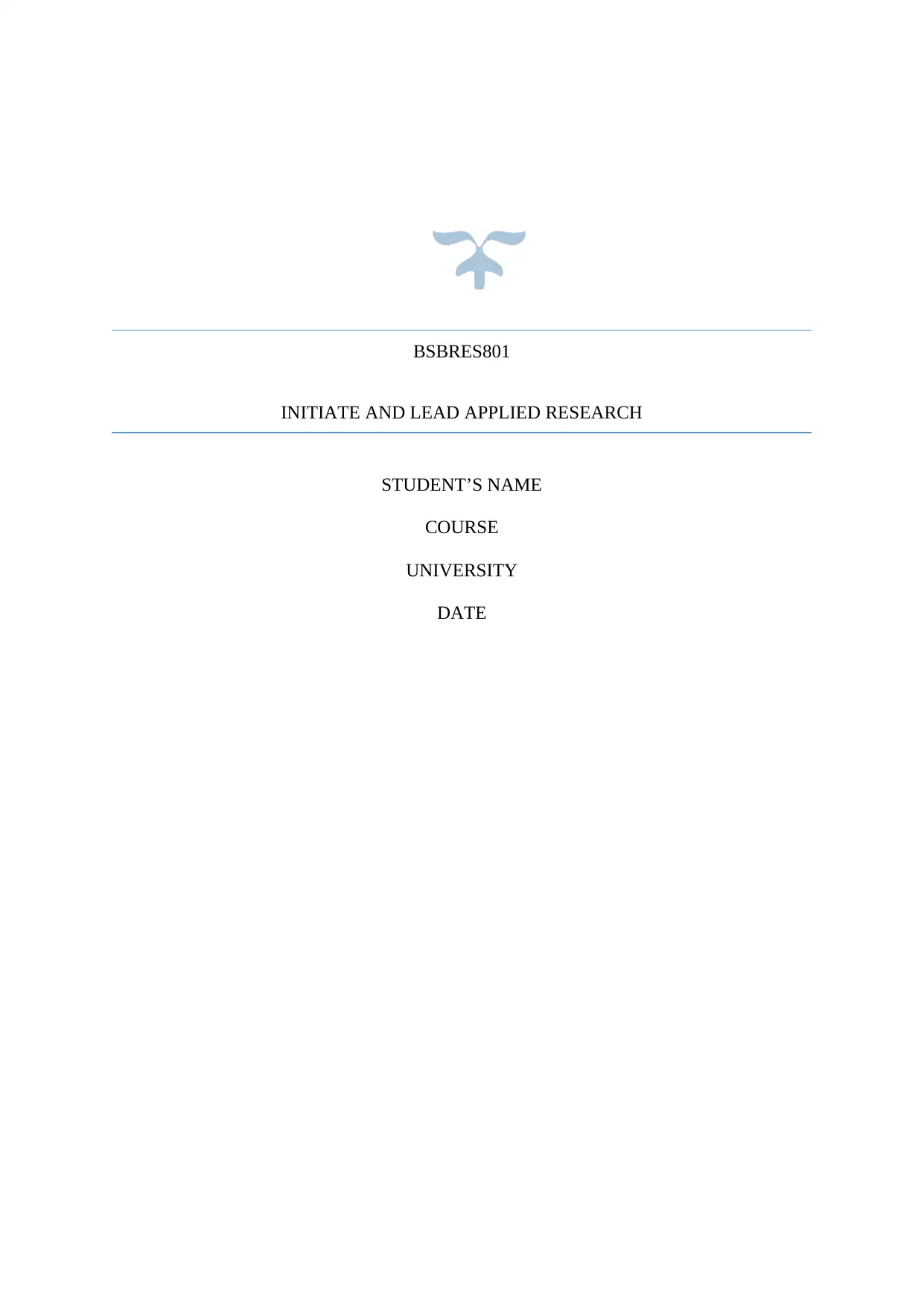
BSBRES801
INITIATE AND LEAD APPLIED RESEARCH
STUDENT’S NAME
COURSE
UNIVERSITY
DATE
INITIATE AND LEAD APPLIED RESEARCH
STUDENT’S NAME
COURSE
UNIVERSITY
DATE
Secure Best Marks with AI Grader
Need help grading? Try our AI Grader for instant feedback on your assignments.
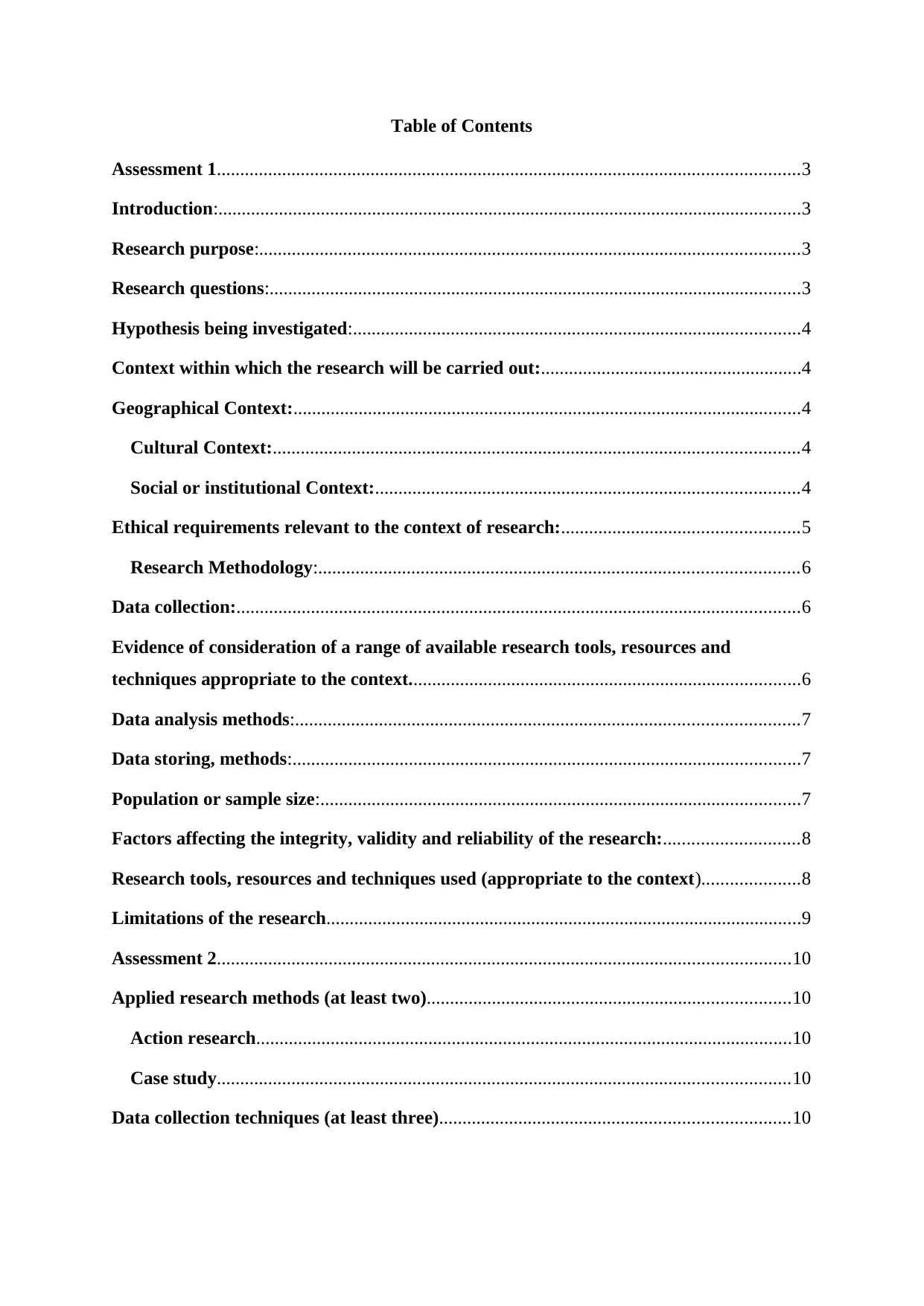
Table of Contents
Assessment 1.............................................................................................................................3
Introduction:.............................................................................................................................3
Research purpose:....................................................................................................................3
Research questions:..................................................................................................................3
Hypothesis being investigated:................................................................................................4
Context within which the research will be carried out:........................................................4
Geographical Context:.............................................................................................................4
Cultural Context:.................................................................................................................4
Social or institutional Context:...........................................................................................4
Ethical requirements relevant to the context of research:...................................................5
Research Methodology:.......................................................................................................6
Data collection:.........................................................................................................................6
Evidence of consideration of a range of available research tools, resources and
techniques appropriate to the context....................................................................................6
Data analysis methods:............................................................................................................7
Data storing, methods:.............................................................................................................7
Population or sample size:.......................................................................................................7
Factors affecting the integrity, validity and reliability of the research:.............................8
Research tools, resources and techniques used (appropriate to the context).....................8
Limitations of the research......................................................................................................9
Assessment 2...........................................................................................................................10
Applied research methods (at least two)..............................................................................10
Action research...................................................................................................................10
Case study...........................................................................................................................10
Data collection techniques (at least three)...........................................................................10
Assessment 1.............................................................................................................................3
Introduction:.............................................................................................................................3
Research purpose:....................................................................................................................3
Research questions:..................................................................................................................3
Hypothesis being investigated:................................................................................................4
Context within which the research will be carried out:........................................................4
Geographical Context:.............................................................................................................4
Cultural Context:.................................................................................................................4
Social or institutional Context:...........................................................................................4
Ethical requirements relevant to the context of research:...................................................5
Research Methodology:.......................................................................................................6
Data collection:.........................................................................................................................6
Evidence of consideration of a range of available research tools, resources and
techniques appropriate to the context....................................................................................6
Data analysis methods:............................................................................................................7
Data storing, methods:.............................................................................................................7
Population or sample size:.......................................................................................................7
Factors affecting the integrity, validity and reliability of the research:.............................8
Research tools, resources and techniques used (appropriate to the context).....................8
Limitations of the research......................................................................................................9
Assessment 2...........................................................................................................................10
Applied research methods (at least two)..............................................................................10
Action research...................................................................................................................10
Case study...........................................................................................................................10
Data collection techniques (at least three)...........................................................................10
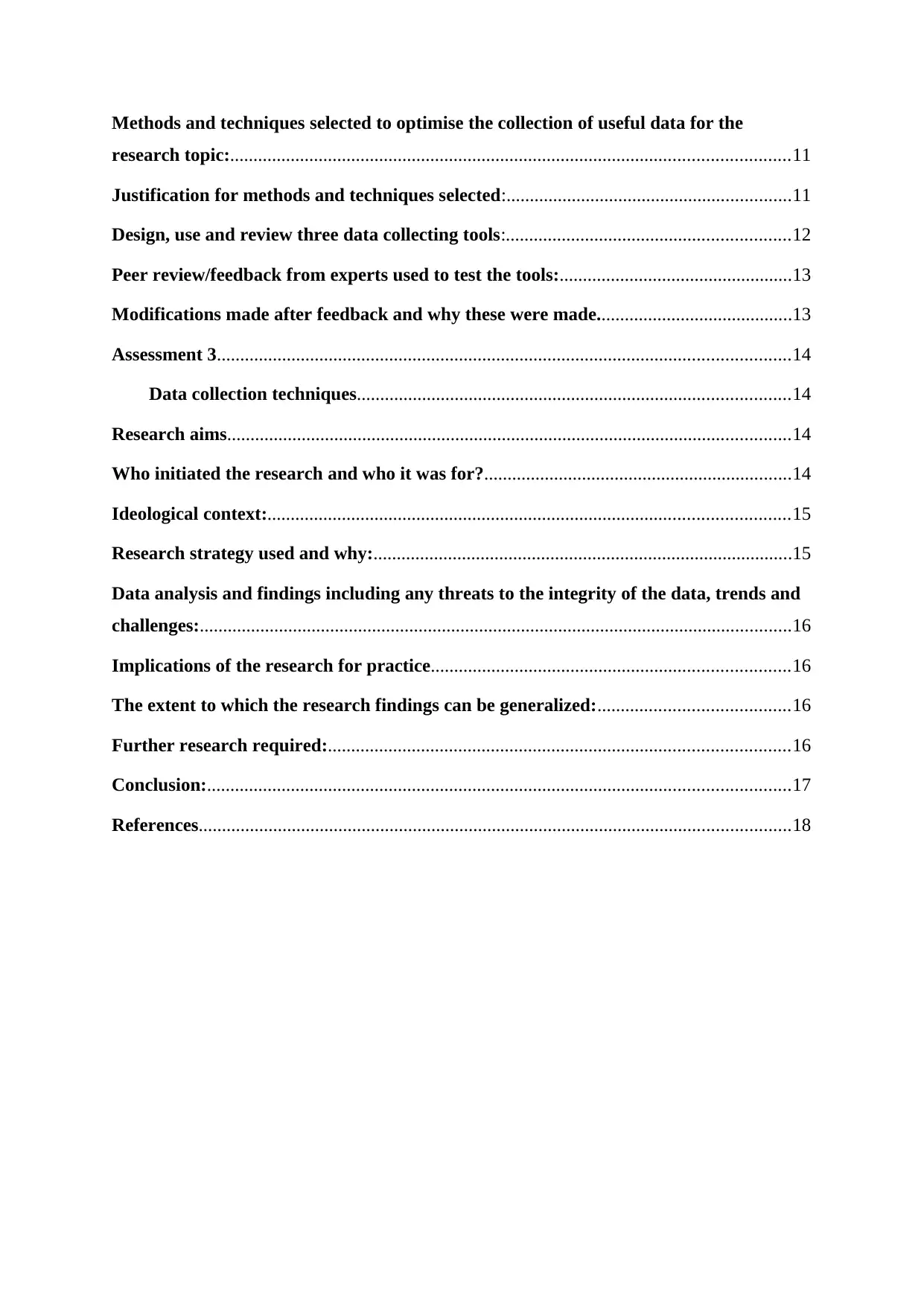
Methods and techniques selected to optimise the collection of useful data for the
research topic:........................................................................................................................11
Justification for methods and techniques selected:.............................................................11
Design, use and review three data collecting tools:.............................................................12
Peer review/feedback from experts used to test the tools:..................................................13
Modifications made after feedback and why these were made..........................................13
Assessment 3...........................................................................................................................14
Data collection techniques.............................................................................................14
Research aims.........................................................................................................................14
Who initiated the research and who it was for?..................................................................14
Ideological context:................................................................................................................15
Research strategy used and why:..........................................................................................15
Data analysis and findings including any threats to the integrity of the data, trends and
challenges:...............................................................................................................................16
Implications of the research for practice.............................................................................16
The extent to which the research findings can be generalized:.........................................16
Further research required:...................................................................................................16
Conclusion:.............................................................................................................................17
References...............................................................................................................................18
research topic:........................................................................................................................11
Justification for methods and techniques selected:.............................................................11
Design, use and review three data collecting tools:.............................................................12
Peer review/feedback from experts used to test the tools:..................................................13
Modifications made after feedback and why these were made..........................................13
Assessment 3...........................................................................................................................14
Data collection techniques.............................................................................................14
Research aims.........................................................................................................................14
Who initiated the research and who it was for?..................................................................14
Ideological context:................................................................................................................15
Research strategy used and why:..........................................................................................15
Data analysis and findings including any threats to the integrity of the data, trends and
challenges:...............................................................................................................................16
Implications of the research for practice.............................................................................16
The extent to which the research findings can be generalized:.........................................16
Further research required:...................................................................................................16
Conclusion:.............................................................................................................................17
References...............................................................................................................................18
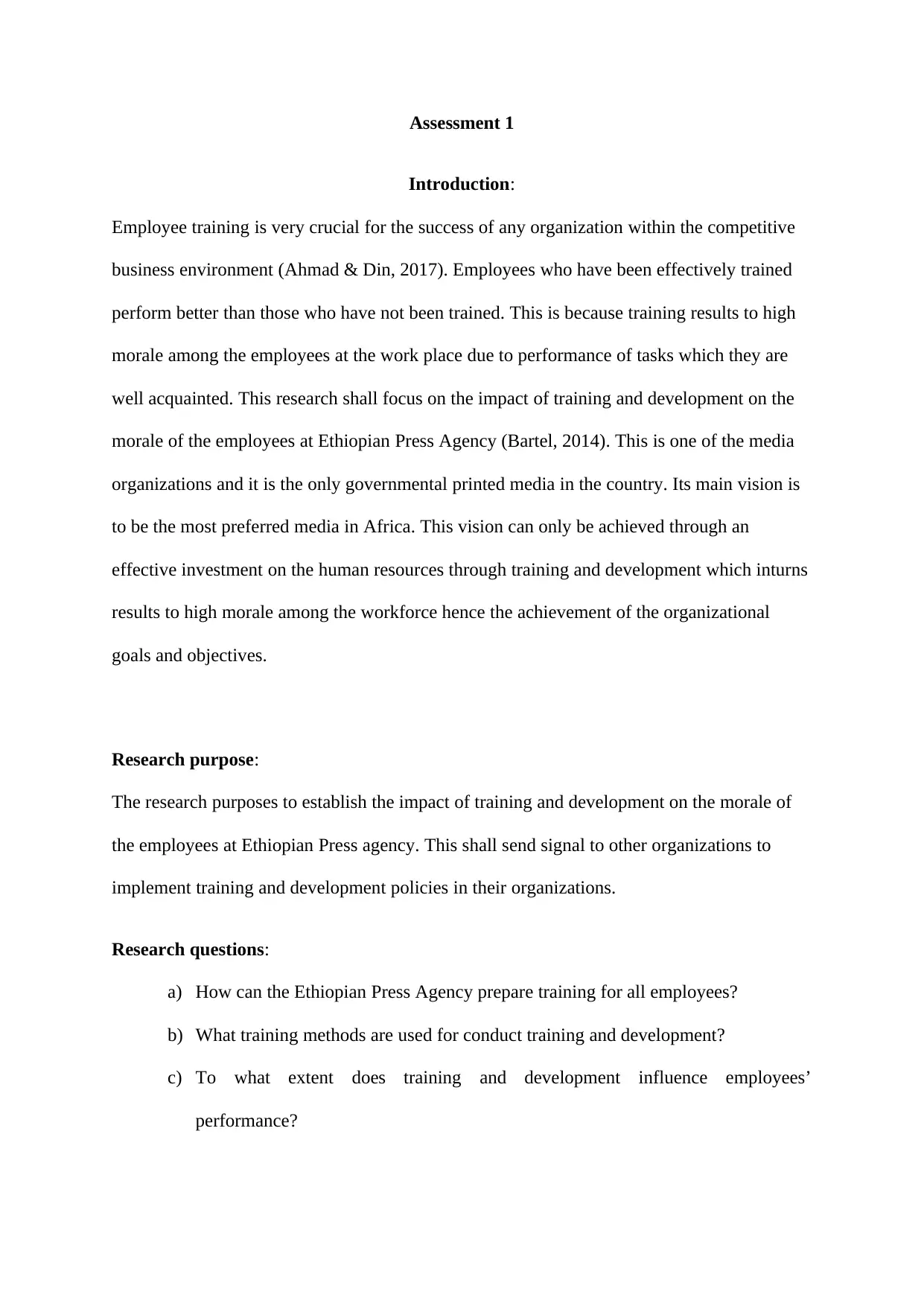
Assessment 1
Introduction:
Employee training is very crucial for the success of any organization within the competitive
business environment (Ahmad & Din, 2017). Employees who have been effectively trained
perform better than those who have not been trained. This is because training results to high
morale among the employees at the work place due to performance of tasks which they are
well acquainted. This research shall focus on the impact of training and development on the
morale of the employees at Ethiopian Press Agency (Bartel, 2014). This is one of the media
organizations and it is the only governmental printed media in the country. Its main vision is
to be the most preferred media in Africa. This vision can only be achieved through an
effective investment on the human resources through training and development which inturns
results to high morale among the workforce hence the achievement of the organizational
goals and objectives.
Research purpose:
The research purposes to establish the impact of training and development on the morale of
the employees at Ethiopian Press agency. This shall send signal to other organizations to
implement training and development policies in their organizations.
Research questions:
a) How can the Ethiopian Press Agency prepare training for all employees?
b) What training methods are used for conduct training and development?
c) To what extent does training and development influence employees’
performance?
Introduction:
Employee training is very crucial for the success of any organization within the competitive
business environment (Ahmad & Din, 2017). Employees who have been effectively trained
perform better than those who have not been trained. This is because training results to high
morale among the employees at the work place due to performance of tasks which they are
well acquainted. This research shall focus on the impact of training and development on the
morale of the employees at Ethiopian Press Agency (Bartel, 2014). This is one of the media
organizations and it is the only governmental printed media in the country. Its main vision is
to be the most preferred media in Africa. This vision can only be achieved through an
effective investment on the human resources through training and development which inturns
results to high morale among the workforce hence the achievement of the organizational
goals and objectives.
Research purpose:
The research purposes to establish the impact of training and development on the morale of
the employees at Ethiopian Press agency. This shall send signal to other organizations to
implement training and development policies in their organizations.
Research questions:
a) How can the Ethiopian Press Agency prepare training for all employees?
b) What training methods are used for conduct training and development?
c) To what extent does training and development influence employees’
performance?
Secure Best Marks with AI Grader
Need help grading? Try our AI Grader for instant feedback on your assignments.
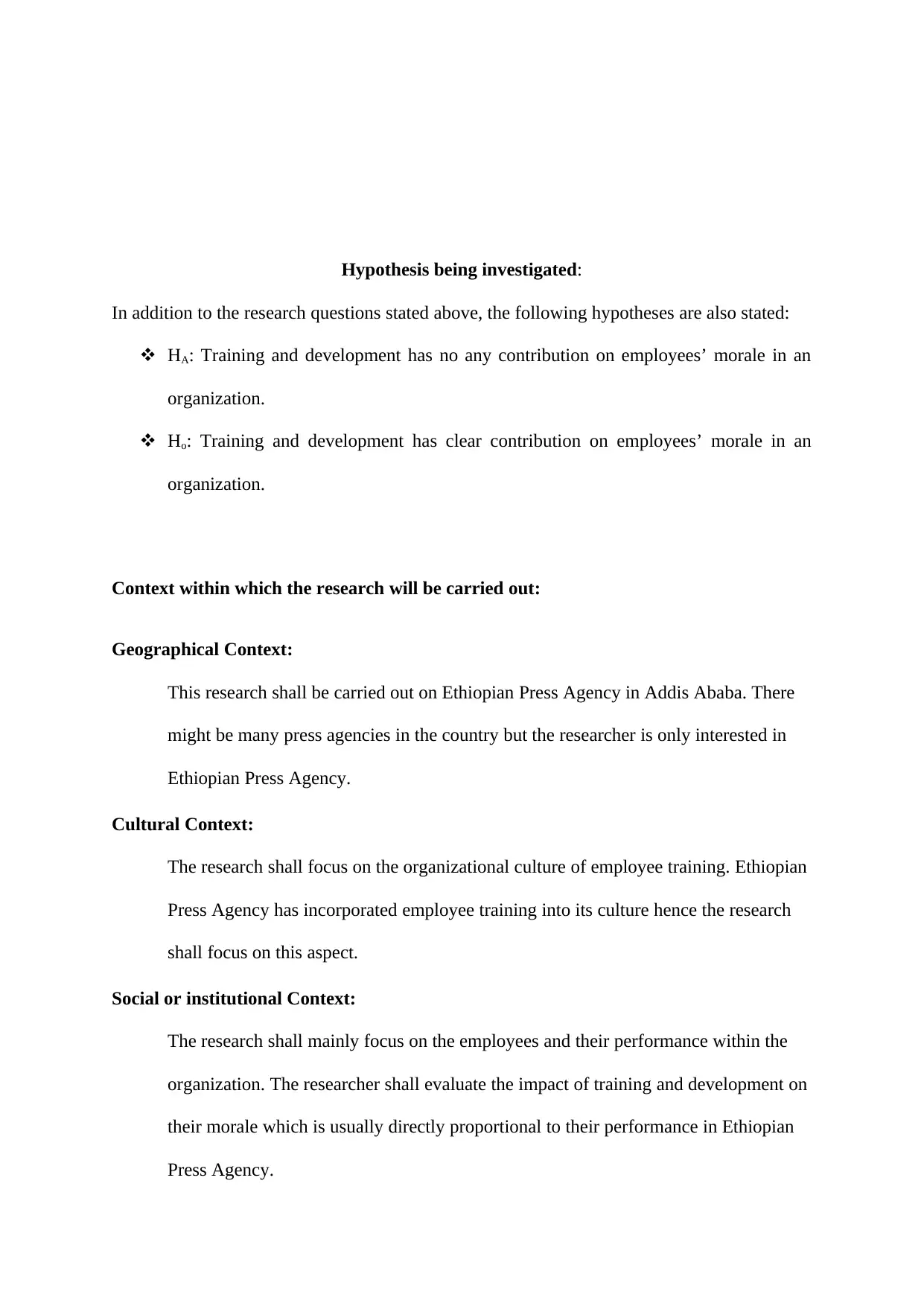
Hypothesis being investigated:
In addition to the research questions stated above, the following hypotheses are also stated:
HA: Training and development has no any contribution on employees’ morale in an
organization.
Ho: Training and development has clear contribution on employees’ morale in an
organization.
Context within which the research will be carried out:
Geographical Context:
This research shall be carried out on Ethiopian Press Agency in Addis Ababa. There
might be many press agencies in the country but the researcher is only interested in
Ethiopian Press Agency.
Cultural Context:
The research shall focus on the organizational culture of employee training. Ethiopian
Press Agency has incorporated employee training into its culture hence the research
shall focus on this aspect.
Social or institutional Context:
The research shall mainly focus on the employees and their performance within the
organization. The researcher shall evaluate the impact of training and development on
their morale which is usually directly proportional to their performance in Ethiopian
Press Agency.
In addition to the research questions stated above, the following hypotheses are also stated:
HA: Training and development has no any contribution on employees’ morale in an
organization.
Ho: Training and development has clear contribution on employees’ morale in an
organization.
Context within which the research will be carried out:
Geographical Context:
This research shall be carried out on Ethiopian Press Agency in Addis Ababa. There
might be many press agencies in the country but the researcher is only interested in
Ethiopian Press Agency.
Cultural Context:
The research shall focus on the organizational culture of employee training. Ethiopian
Press Agency has incorporated employee training into its culture hence the research
shall focus on this aspect.
Social or institutional Context:
The research shall mainly focus on the employees and their performance within the
organization. The researcher shall evaluate the impact of training and development on
their morale which is usually directly proportional to their performance in Ethiopian
Press Agency.
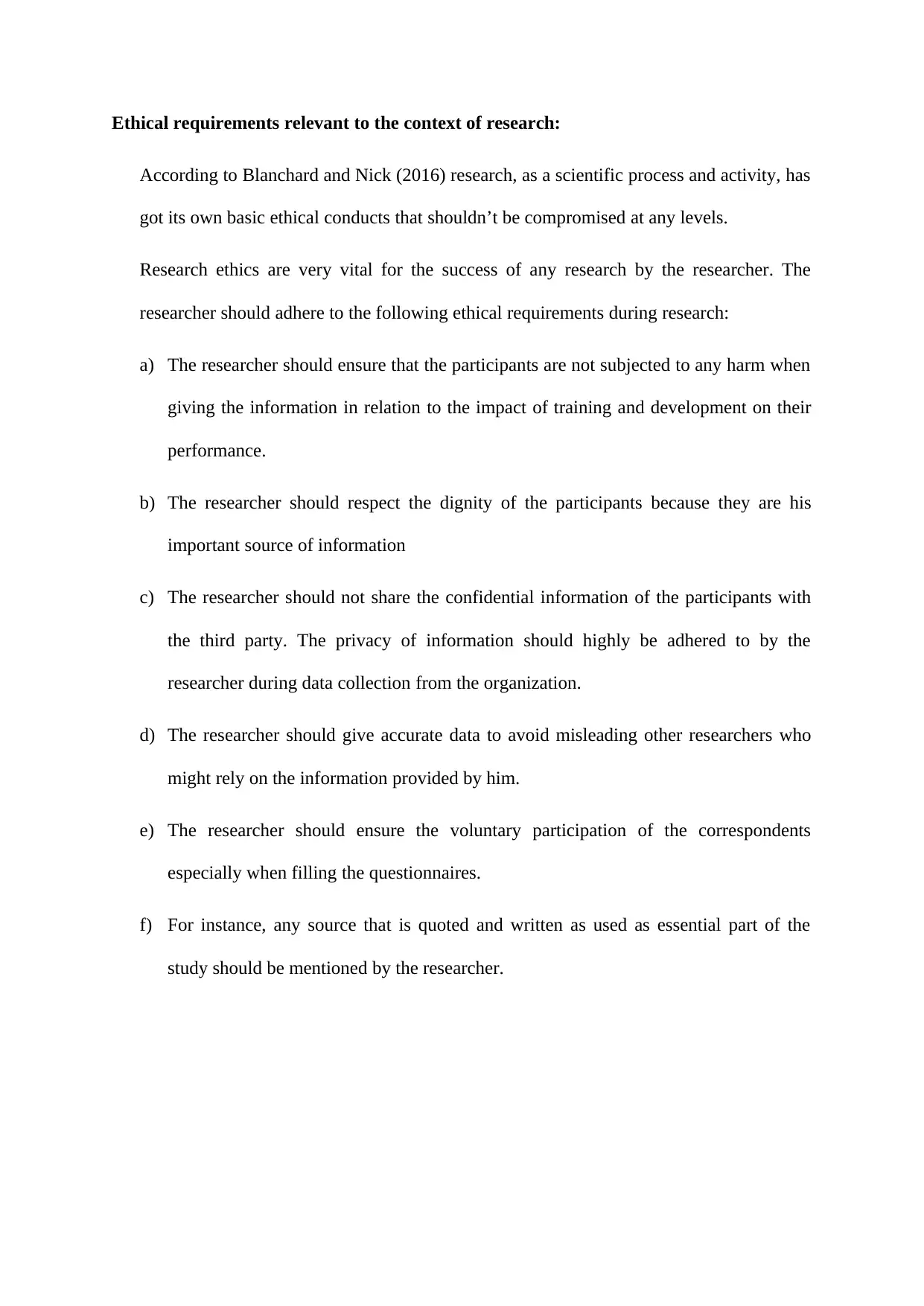
Ethical requirements relevant to the context of research:
According to Blanchard and Nick (2016) research, as a scientific process and activity, has
got its own basic ethical conducts that shouldn’t be compromised at any levels.
Research ethics are very vital for the success of any research by the researcher. The
researcher should adhere to the following ethical requirements during research:
a) The researcher should ensure that the participants are not subjected to any harm when
giving the information in relation to the impact of training and development on their
performance.
b) The researcher should respect the dignity of the participants because they are his
important source of information
c) The researcher should not share the confidential information of the participants with
the third party. The privacy of information should highly be adhered to by the
researcher during data collection from the organization.
d) The researcher should give accurate data to avoid misleading other researchers who
might rely on the information provided by him.
e) The researcher should ensure the voluntary participation of the correspondents
especially when filling the questionnaires.
f) For instance, any source that is quoted and written as used as essential part of the
study should be mentioned by the researcher.
According to Blanchard and Nick (2016) research, as a scientific process and activity, has
got its own basic ethical conducts that shouldn’t be compromised at any levels.
Research ethics are very vital for the success of any research by the researcher. The
researcher should adhere to the following ethical requirements during research:
a) The researcher should ensure that the participants are not subjected to any harm when
giving the information in relation to the impact of training and development on their
performance.
b) The researcher should respect the dignity of the participants because they are his
important source of information
c) The researcher should not share the confidential information of the participants with
the third party. The privacy of information should highly be adhered to by the
researcher during data collection from the organization.
d) The researcher should give accurate data to avoid misleading other researchers who
might rely on the information provided by him.
e) The researcher should ensure the voluntary participation of the correspondents
especially when filling the questionnaires.
f) For instance, any source that is quoted and written as used as essential part of the
study should be mentioned by the researcher.
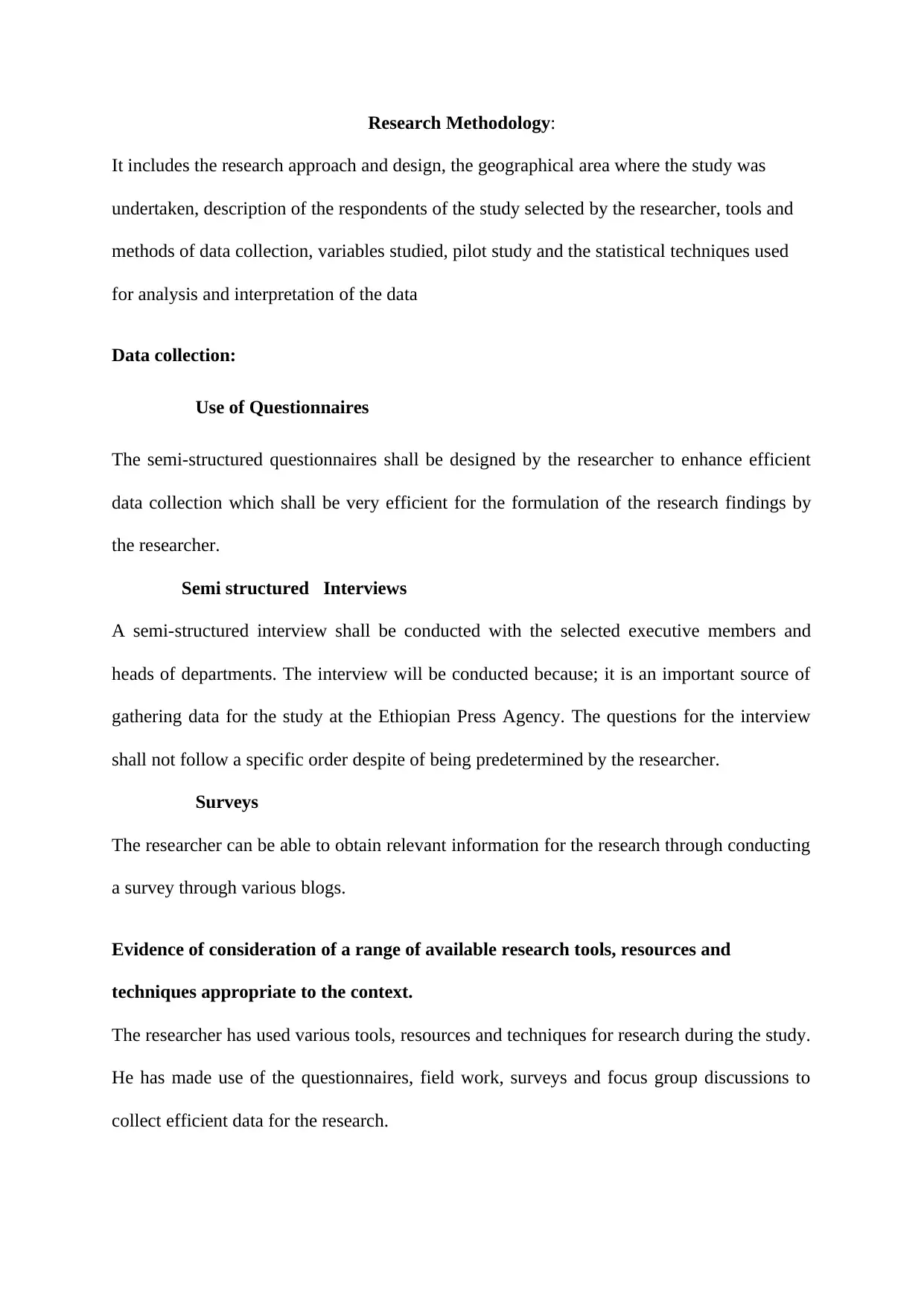
Research Methodology:
It includes the research approach and design, the geographical area where the study was
undertaken, description of the respondents of the study selected by the researcher, tools and
methods of data collection, variables studied, pilot study and the statistical techniques used
for analysis and interpretation of the data
Data collection:
Use of Questionnaires
The semi-structured questionnaires shall be designed by the researcher to enhance efficient
data collection which shall be very efficient for the formulation of the research findings by
the researcher.
Semi structured Interviews
A semi-structured interview shall be conducted with the selected executive members and
heads of departments. The interview will be conducted because; it is an important source of
gathering data for the study at the Ethiopian Press Agency. The questions for the interview
shall not follow a specific order despite of being predetermined by the researcher.
Surveys
The researcher can be able to obtain relevant information for the research through conducting
a survey through various blogs.
Evidence of consideration of a range of available research tools, resources and
techniques appropriate to the context.
The researcher has used various tools, resources and techniques for research during the study.
He has made use of the questionnaires, field work, surveys and focus group discussions to
collect efficient data for the research.
It includes the research approach and design, the geographical area where the study was
undertaken, description of the respondents of the study selected by the researcher, tools and
methods of data collection, variables studied, pilot study and the statistical techniques used
for analysis and interpretation of the data
Data collection:
Use of Questionnaires
The semi-structured questionnaires shall be designed by the researcher to enhance efficient
data collection which shall be very efficient for the formulation of the research findings by
the researcher.
Semi structured Interviews
A semi-structured interview shall be conducted with the selected executive members and
heads of departments. The interview will be conducted because; it is an important source of
gathering data for the study at the Ethiopian Press Agency. The questions for the interview
shall not follow a specific order despite of being predetermined by the researcher.
Surveys
The researcher can be able to obtain relevant information for the research through conducting
a survey through various blogs.
Evidence of consideration of a range of available research tools, resources and
techniques appropriate to the context.
The researcher has used various tools, resources and techniques for research during the study.
He has made use of the questionnaires, field work, surveys and focus group discussions to
collect efficient data for the research.
Paraphrase This Document
Need a fresh take? Get an instant paraphrase of this document with our AI Paraphraser
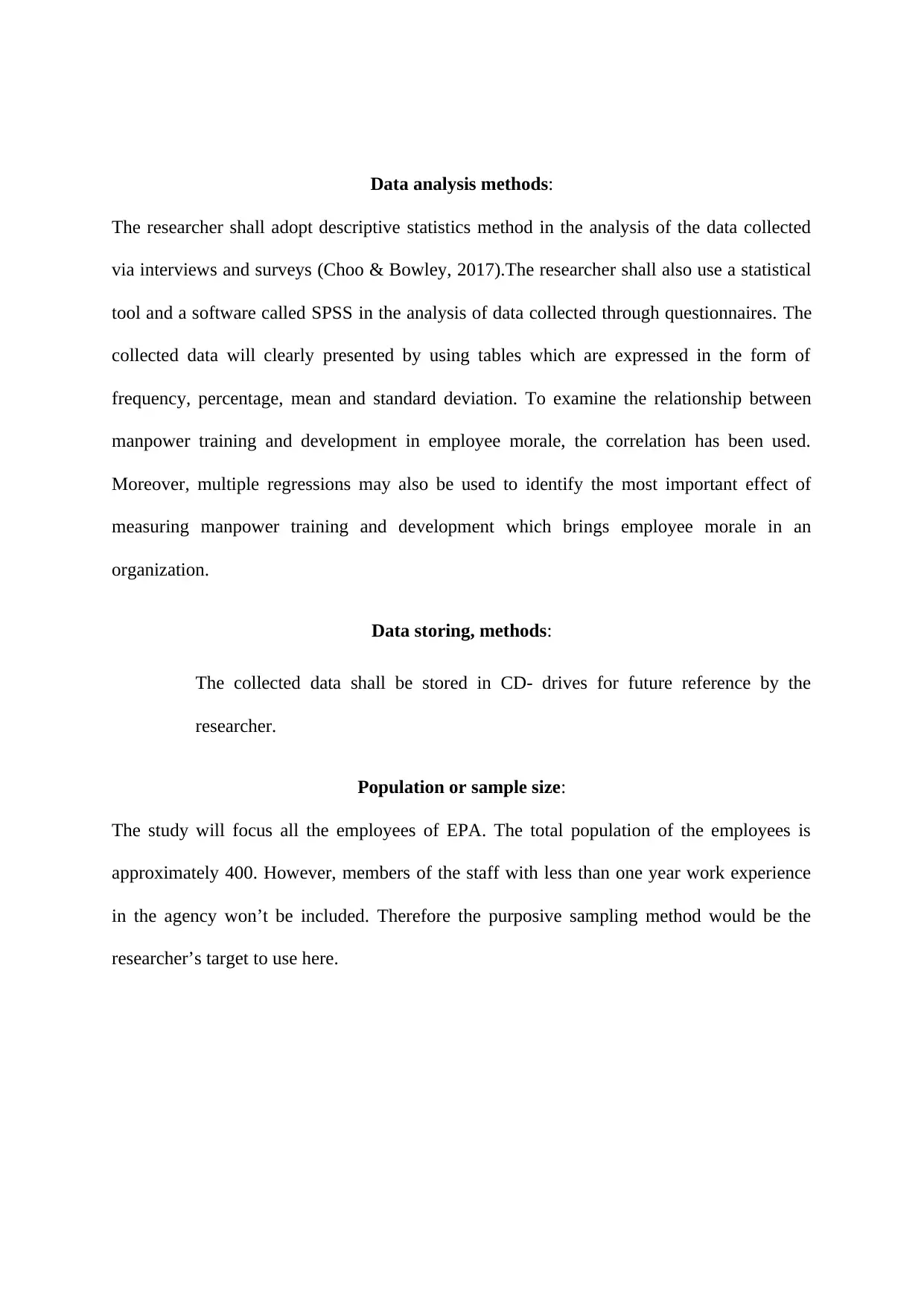
Data analysis methods:
The researcher shall adopt descriptive statistics method in the analysis of the data collected
via interviews and surveys (Choo & Bowley, 2017).The researcher shall also use a statistical
tool and a software called SPSS in the analysis of data collected through questionnaires. The
collected data will clearly presented by using tables which are expressed in the form of
frequency, percentage, mean and standard deviation. To examine the relationship between
manpower training and development in employee morale, the correlation has been used.
Moreover, multiple regressions may also be used to identify the most important effect of
measuring manpower training and development which brings employee morale in an
organization.
Data storing, methods:
The collected data shall be stored in CD- drives for future reference by the
researcher.
Population or sample size:
The study will focus all the employees of EPA. The total population of the employees is
approximately 400. However, members of the staff with less than one year work experience
in the agency won’t be included. Therefore the purposive sampling method would be the
researcher’s target to use here.
The researcher shall adopt descriptive statistics method in the analysis of the data collected
via interviews and surveys (Choo & Bowley, 2017).The researcher shall also use a statistical
tool and a software called SPSS in the analysis of data collected through questionnaires. The
collected data will clearly presented by using tables which are expressed in the form of
frequency, percentage, mean and standard deviation. To examine the relationship between
manpower training and development in employee morale, the correlation has been used.
Moreover, multiple regressions may also be used to identify the most important effect of
measuring manpower training and development which brings employee morale in an
organization.
Data storing, methods:
The collected data shall be stored in CD- drives for future reference by the
researcher.
Population or sample size:
The study will focus all the employees of EPA. The total population of the employees is
approximately 400. However, members of the staff with less than one year work experience
in the agency won’t be included. Therefore the purposive sampling method would be the
researcher’s target to use here.
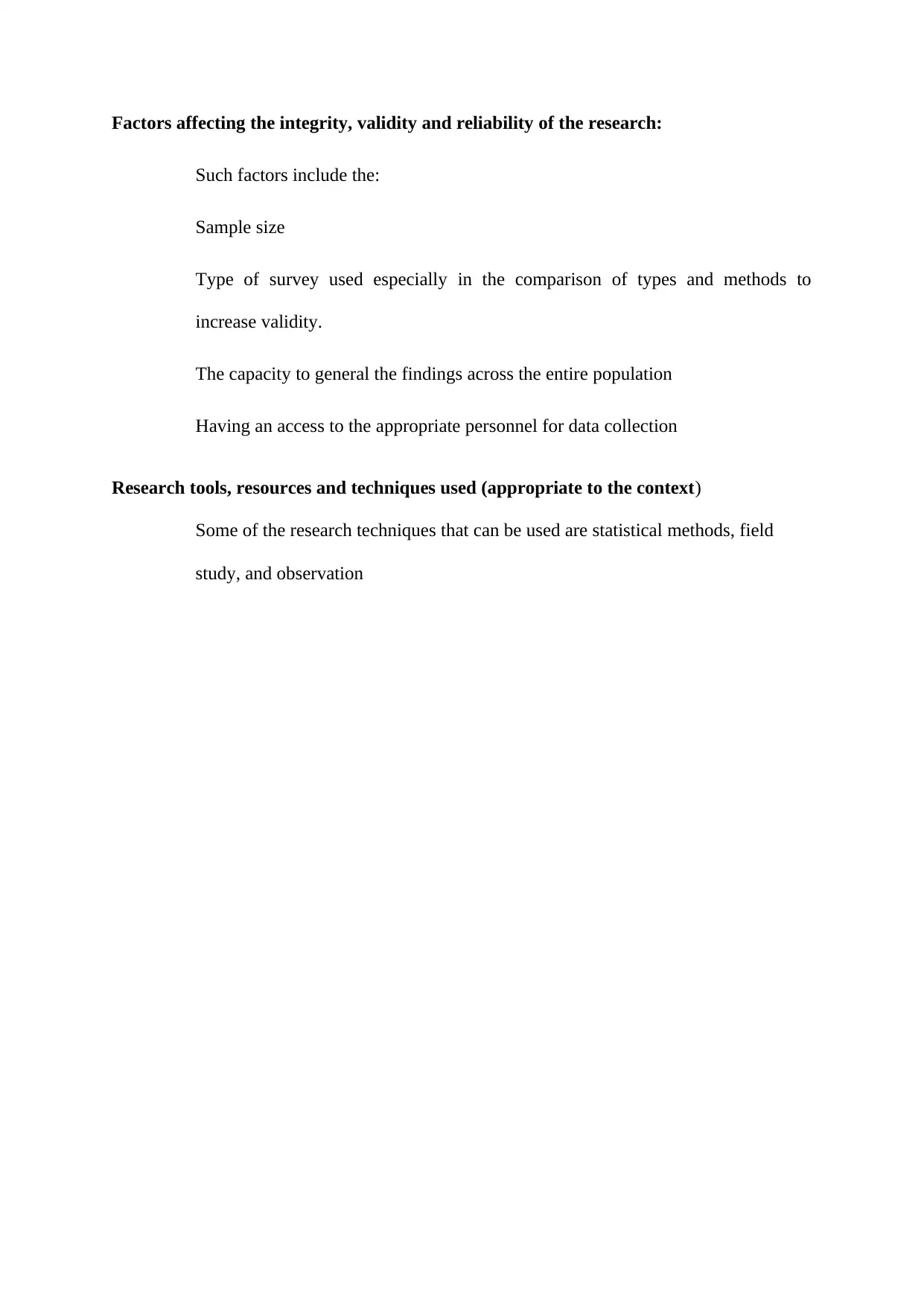
Factors affecting the integrity, validity and reliability of the research:
Such factors include the:
Sample size
Type of survey used especially in the comparison of types and methods to
increase validity.
The capacity to general the findings across the entire population
Having an access to the appropriate personnel for data collection
Research tools, resources and techniques used (appropriate to the context)
Some of the research techniques that can be used are statistical methods, field
study, and observation
Such factors include the:
Sample size
Type of survey used especially in the comparison of types and methods to
increase validity.
The capacity to general the findings across the entire population
Having an access to the appropriate personnel for data collection
Research tools, resources and techniques used (appropriate to the context)
Some of the research techniques that can be used are statistical methods, field
study, and observation
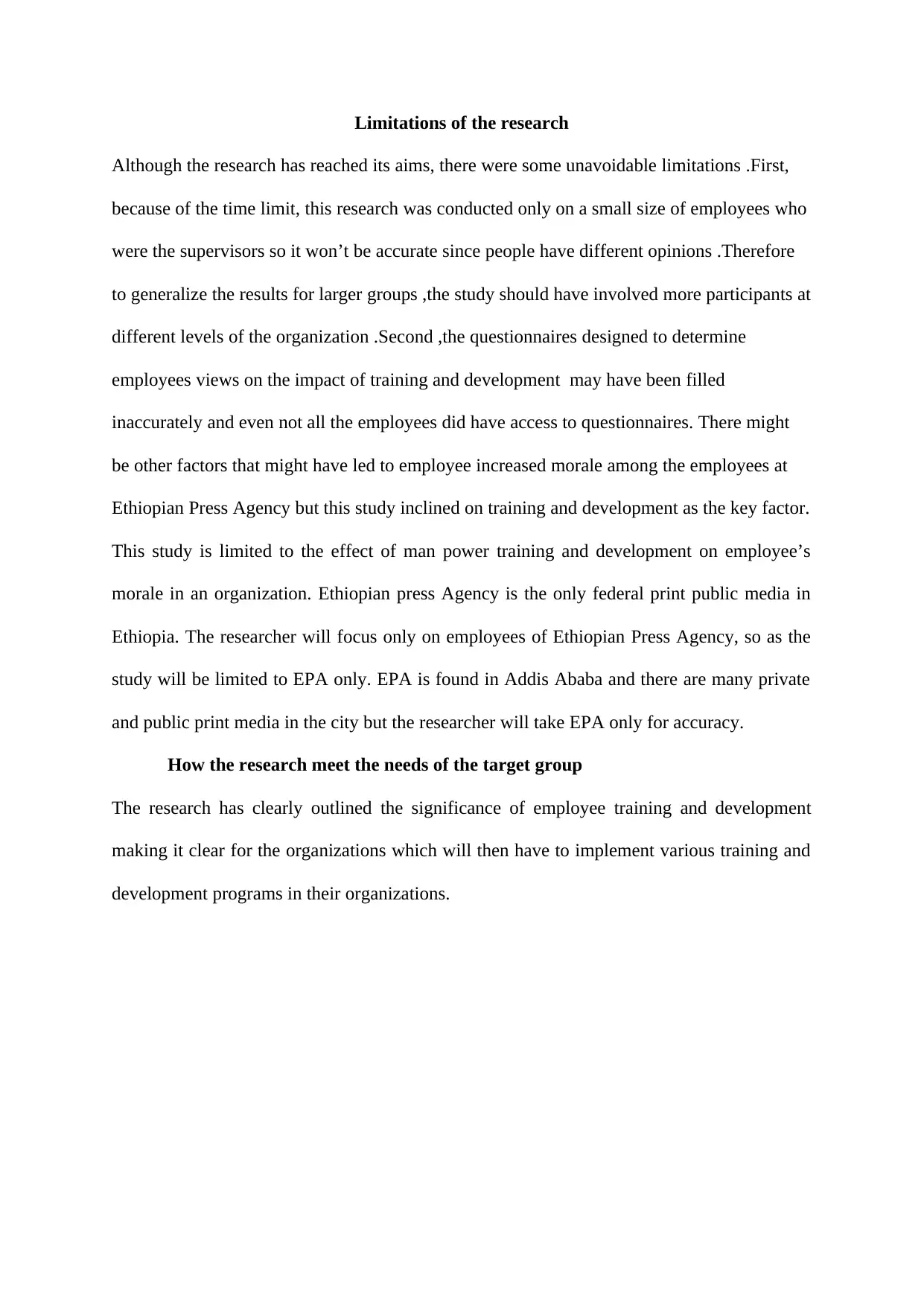
Limitations of the research
Although the research has reached its aims, there were some unavoidable limitations .First,
because of the time limit, this research was conducted only on a small size of employees who
were the supervisors so it won’t be accurate since people have different opinions .Therefore
to generalize the results for larger groups ,the study should have involved more participants at
different levels of the organization .Second ,the questionnaires designed to determine
employees views on the impact of training and development may have been filled
inaccurately and even not all the employees did have access to questionnaires. There might
be other factors that might have led to employee increased morale among the employees at
Ethiopian Press Agency but this study inclined on training and development as the key factor.
This study is limited to the effect of man power training and development on employee’s
morale in an organization. Ethiopian press Agency is the only federal print public media in
Ethiopia. The researcher will focus only on employees of Ethiopian Press Agency, so as the
study will be limited to EPA only. EPA is found in Addis Ababa and there are many private
and public print media in the city but the researcher will take EPA only for accuracy.
How the research meet the needs of the target group
The research has clearly outlined the significance of employee training and development
making it clear for the organizations which will then have to implement various training and
development programs in their organizations.
Although the research has reached its aims, there were some unavoidable limitations .First,
because of the time limit, this research was conducted only on a small size of employees who
were the supervisors so it won’t be accurate since people have different opinions .Therefore
to generalize the results for larger groups ,the study should have involved more participants at
different levels of the organization .Second ,the questionnaires designed to determine
employees views on the impact of training and development may have been filled
inaccurately and even not all the employees did have access to questionnaires. There might
be other factors that might have led to employee increased morale among the employees at
Ethiopian Press Agency but this study inclined on training and development as the key factor.
This study is limited to the effect of man power training and development on employee’s
morale in an organization. Ethiopian press Agency is the only federal print public media in
Ethiopia. The researcher will focus only on employees of Ethiopian Press Agency, so as the
study will be limited to EPA only. EPA is found in Addis Ababa and there are many private
and public print media in the city but the researcher will take EPA only for accuracy.
How the research meet the needs of the target group
The research has clearly outlined the significance of employee training and development
making it clear for the organizations which will then have to implement various training and
development programs in their organizations.
Secure Best Marks with AI Grader
Need help grading? Try our AI Grader for instant feedback on your assignments.
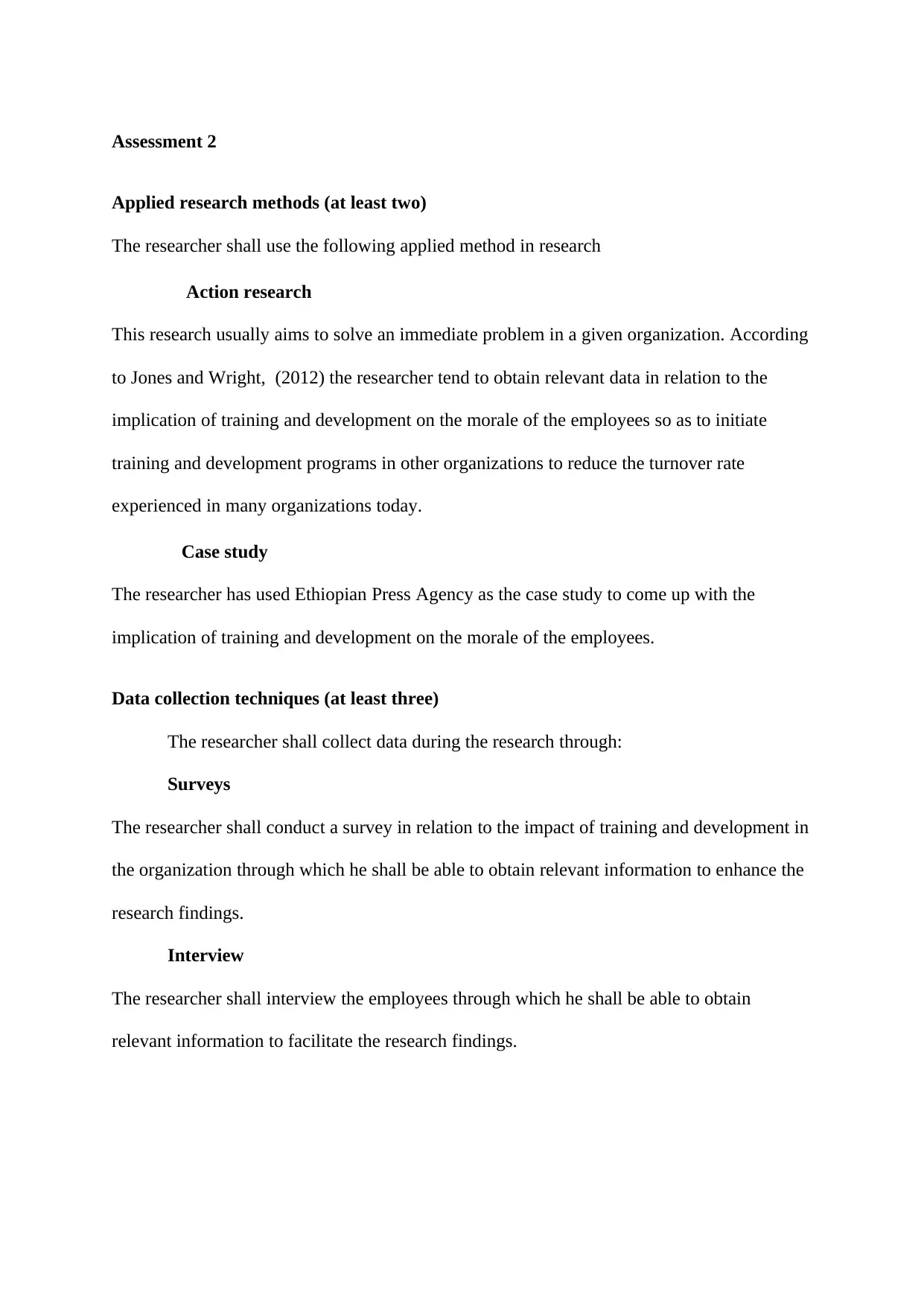
Assessment 2
Applied research methods (at least two)
The researcher shall use the following applied method in research
Action research
This research usually aims to solve an immediate problem in a given organization. According
to Jones and Wright, (2012) the researcher tend to obtain relevant data in relation to the
implication of training and development on the morale of the employees so as to initiate
training and development programs in other organizations to reduce the turnover rate
experienced in many organizations today.
Case study
The researcher has used Ethiopian Press Agency as the case study to come up with the
implication of training and development on the morale of the employees.
Data collection techniques (at least three)
The researcher shall collect data during the research through:
Surveys
The researcher shall conduct a survey in relation to the impact of training and development in
the organization through which he shall be able to obtain relevant information to enhance the
research findings.
Interview
The researcher shall interview the employees through which he shall be able to obtain
relevant information to facilitate the research findings.
Applied research methods (at least two)
The researcher shall use the following applied method in research
Action research
This research usually aims to solve an immediate problem in a given organization. According
to Jones and Wright, (2012) the researcher tend to obtain relevant data in relation to the
implication of training and development on the morale of the employees so as to initiate
training and development programs in other organizations to reduce the turnover rate
experienced in many organizations today.
Case study
The researcher has used Ethiopian Press Agency as the case study to come up with the
implication of training and development on the morale of the employees.
Data collection techniques (at least three)
The researcher shall collect data during the research through:
Surveys
The researcher shall conduct a survey in relation to the impact of training and development in
the organization through which he shall be able to obtain relevant information to enhance the
research findings.
Interview
The researcher shall interview the employees through which he shall be able to obtain
relevant information to facilitate the research findings.
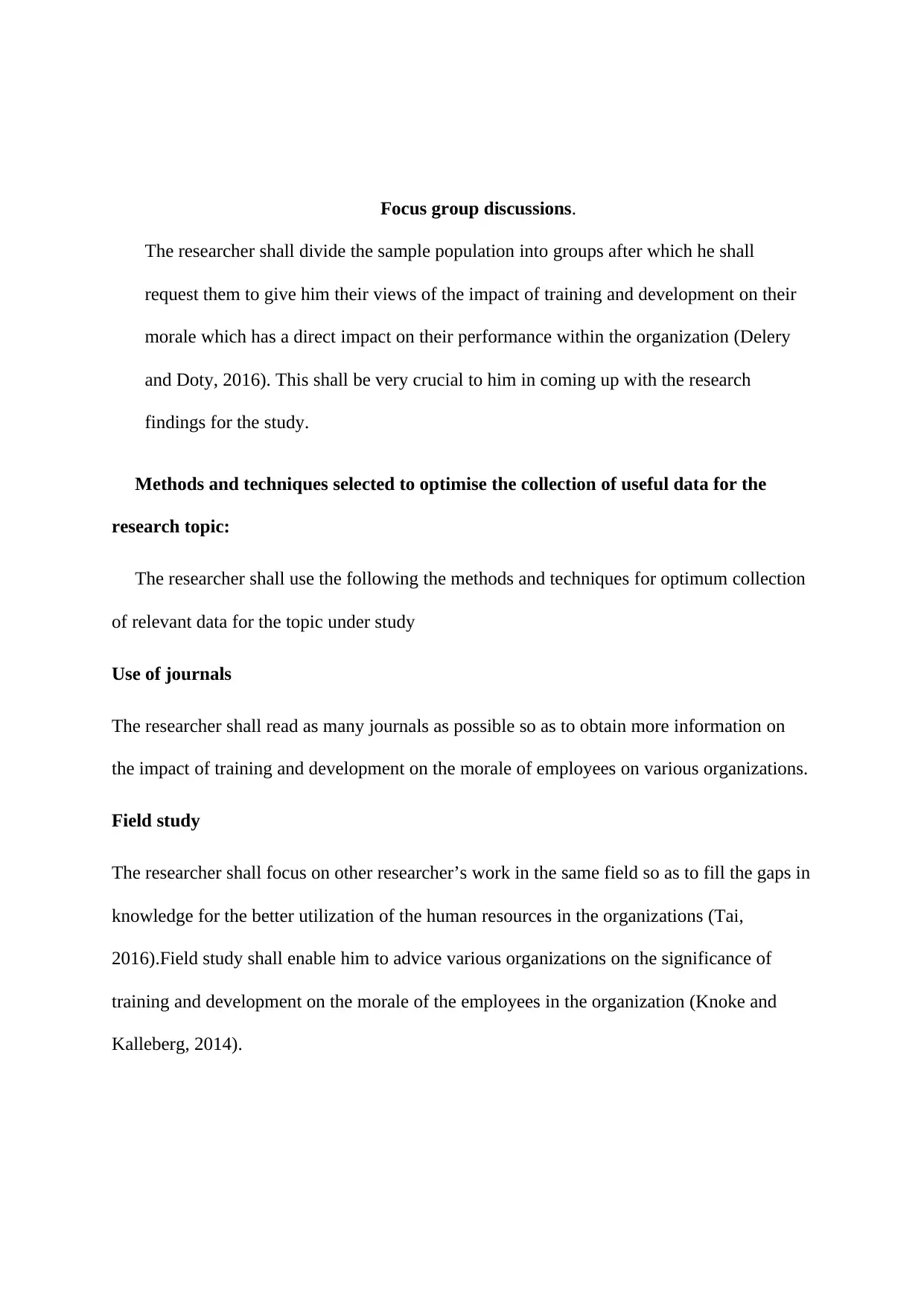
Focus group discussions.
The researcher shall divide the sample population into groups after which he shall
request them to give him their views of the impact of training and development on their
morale which has a direct impact on their performance within the organization (Delery
and Doty, 2016). This shall be very crucial to him in coming up with the research
findings for the study.
Methods and techniques selected to optimise the collection of useful data for the
research topic:
The researcher shall use the following the methods and techniques for optimum collection
of relevant data for the topic under study
Use of journals
The researcher shall read as many journals as possible so as to obtain more information on
the impact of training and development on the morale of employees on various organizations.
Field study
The researcher shall focus on other researcher’s work in the same field so as to fill the gaps in
knowledge for the better utilization of the human resources in the organizations (Tai,
2016).Field study shall enable him to advice various organizations on the significance of
training and development on the morale of the employees in the organization (Knoke and
Kalleberg, 2014).
The researcher shall divide the sample population into groups after which he shall
request them to give him their views of the impact of training and development on their
morale which has a direct impact on their performance within the organization (Delery
and Doty, 2016). This shall be very crucial to him in coming up with the research
findings for the study.
Methods and techniques selected to optimise the collection of useful data for the
research topic:
The researcher shall use the following the methods and techniques for optimum collection
of relevant data for the topic under study
Use of journals
The researcher shall read as many journals as possible so as to obtain more information on
the impact of training and development on the morale of employees on various organizations.
Field study
The researcher shall focus on other researcher’s work in the same field so as to fill the gaps in
knowledge for the better utilization of the human resources in the organizations (Tai,
2016).Field study shall enable him to advice various organizations on the significance of
training and development on the morale of the employees in the organization (Knoke and
Kalleberg, 2014).

Justification for methods and techniques selected:
Use of journals
Through the use of journals the researcher shall be able to have an access to a wide source of
ideas which shall enhance appropriate research findings (Noe, 2011).
Field study
This method is very efficient because the researcher shall be able to compare his thoughts
with what others had already done for effective research findings and conclusion.
Design, use and review three data collecting tools:
The following are the data collection tools that shall be used by the researcher during
his research at the Ethiopian Press Agency:
Questionnaires
A semi-structured questionnaire shall be used by the researcher to collect relevant data from
the population under study. According to Kumpikaitė (2018) the questionnaires shall have
questions revolving around career development and how employees perceive the
influence it has on their morale which has a direct impact on their performance within the
organization. The participants shall be the employees within the organization and they
shall be instructed to be genuine when filling the questionnaire.
Use of journals
Through the use of journals the researcher shall be able to have an access to a wide source of
ideas which shall enhance appropriate research findings (Noe, 2011).
Field study
This method is very efficient because the researcher shall be able to compare his thoughts
with what others had already done for effective research findings and conclusion.
Design, use and review three data collecting tools:
The following are the data collection tools that shall be used by the researcher during
his research at the Ethiopian Press Agency:
Questionnaires
A semi-structured questionnaire shall be used by the researcher to collect relevant data from
the population under study. According to Kumpikaitė (2018) the questionnaires shall have
questions revolving around career development and how employees perceive the
influence it has on their morale which has a direct impact on their performance within the
organization. The participants shall be the employees within the organization and they
shall be instructed to be genuine when filling the questionnaire.
Paraphrase This Document
Need a fresh take? Get an instant paraphrase of this document with our AI Paraphraser
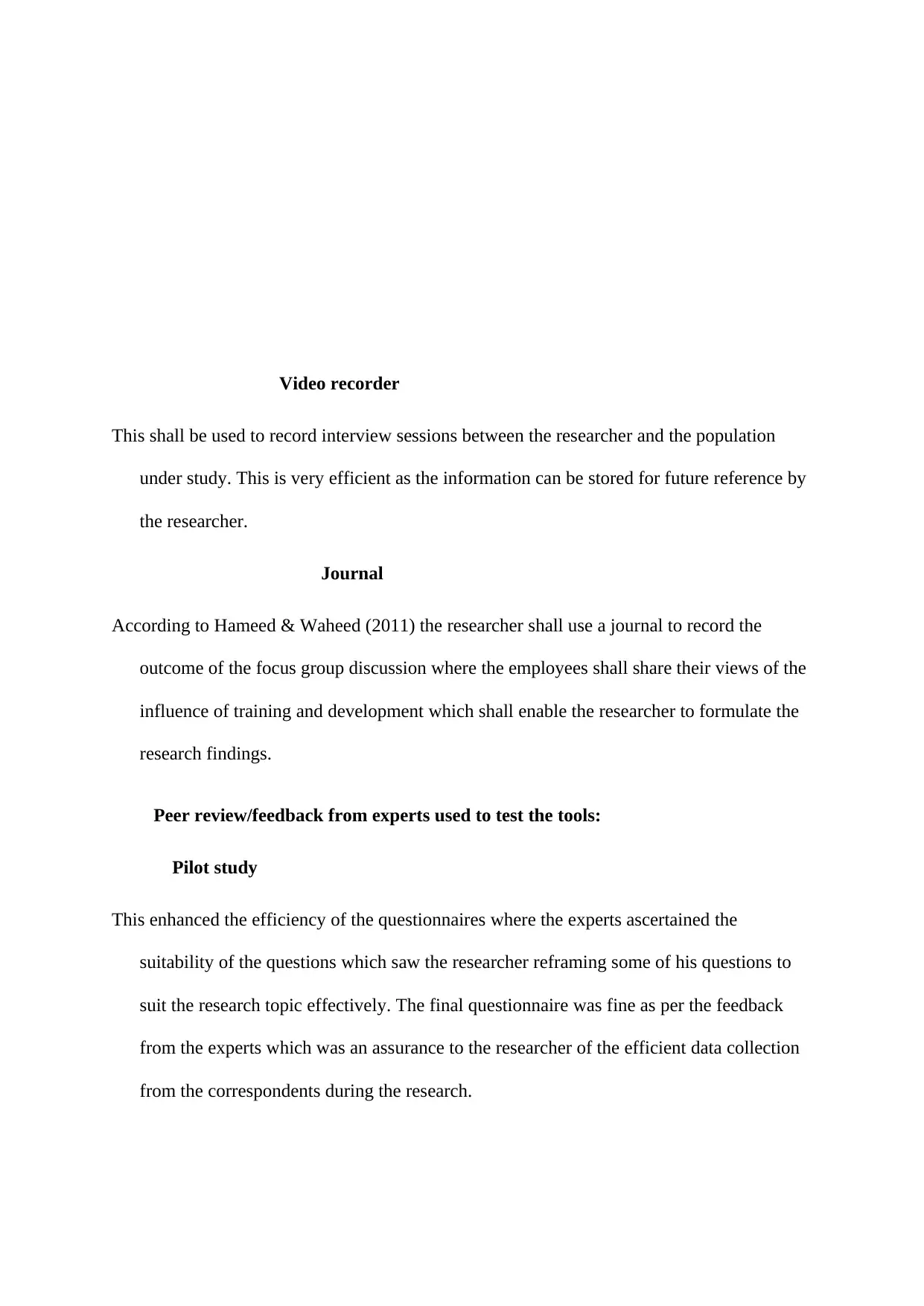
Video recorder
This shall be used to record interview sessions between the researcher and the population
under study. This is very efficient as the information can be stored for future reference by
the researcher.
Journal
According to Hameed & Waheed (2011) the researcher shall use a journal to record the
outcome of the focus group discussion where the employees shall share their views of the
influence of training and development which shall enable the researcher to formulate the
research findings.
Peer review/feedback from experts used to test the tools:
Pilot study
This enhanced the efficiency of the questionnaires where the experts ascertained the
suitability of the questions which saw the researcher reframing some of his questions to
suit the research topic effectively. The final questionnaire was fine as per the feedback
from the experts which was an assurance to the researcher of the efficient data collection
from the correspondents during the research.
This shall be used to record interview sessions between the researcher and the population
under study. This is very efficient as the information can be stored for future reference by
the researcher.
Journal
According to Hameed & Waheed (2011) the researcher shall use a journal to record the
outcome of the focus group discussion where the employees shall share their views of the
influence of training and development which shall enable the researcher to formulate the
research findings.
Peer review/feedback from experts used to test the tools:
Pilot study
This enhanced the efficiency of the questionnaires where the experts ascertained the
suitability of the questions which saw the researcher reframing some of his questions to
suit the research topic effectively. The final questionnaire was fine as per the feedback
from the experts which was an assurance to the researcher of the efficient data collection
from the correspondents during the research.
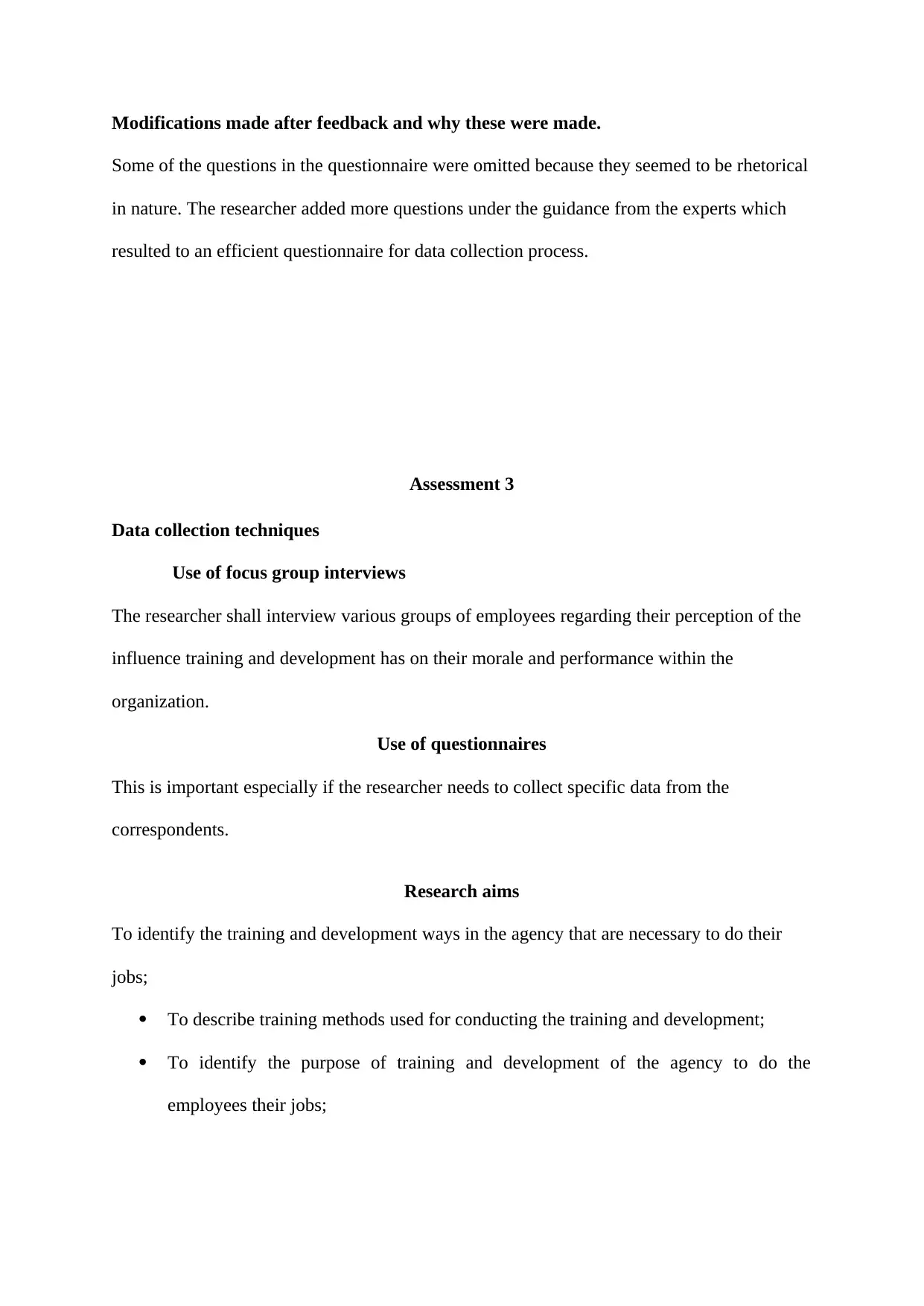
Modifications made after feedback and why these were made.
Some of the questions in the questionnaire were omitted because they seemed to be rhetorical
in nature. The researcher added more questions under the guidance from the experts which
resulted to an efficient questionnaire for data collection process.
Assessment 3
Data collection techniques
Use of focus group interviews
The researcher shall interview various groups of employees regarding their perception of the
influence training and development has on their morale and performance within the
organization.
Use of questionnaires
This is important especially if the researcher needs to collect specific data from the
correspondents.
Research aims
To identify the training and development ways in the agency that are necessary to do their
jobs;
To describe training methods used for conducting the training and development;
To identify the purpose of training and development of the agency to do the
employees their jobs;
Some of the questions in the questionnaire were omitted because they seemed to be rhetorical
in nature. The researcher added more questions under the guidance from the experts which
resulted to an efficient questionnaire for data collection process.
Assessment 3
Data collection techniques
Use of focus group interviews
The researcher shall interview various groups of employees regarding their perception of the
influence training and development has on their morale and performance within the
organization.
Use of questionnaires
This is important especially if the researcher needs to collect specific data from the
correspondents.
Research aims
To identify the training and development ways in the agency that are necessary to do their
jobs;
To describe training methods used for conducting the training and development;
To identify the purpose of training and development of the agency to do the
employees their jobs;
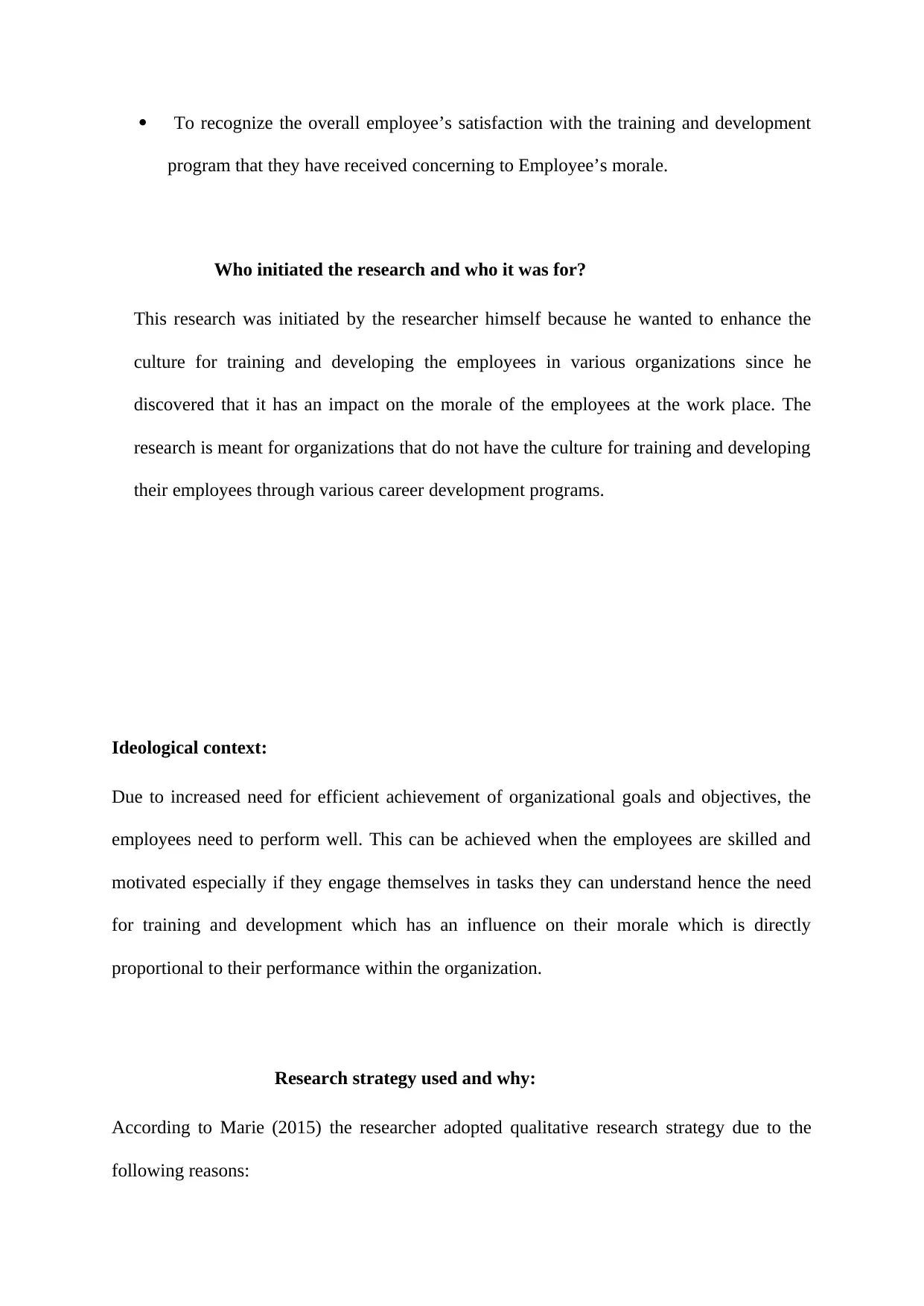
To recognize the overall employee’s satisfaction with the training and development
program that they have received concerning to Employee’s morale.
Who initiated the research and who it was for?
This research was initiated by the researcher himself because he wanted to enhance the
culture for training and developing the employees in various organizations since he
discovered that it has an impact on the morale of the employees at the work place. The
research is meant for organizations that do not have the culture for training and developing
their employees through various career development programs.
Ideological context:
Due to increased need for efficient achievement of organizational goals and objectives, the
employees need to perform well. This can be achieved when the employees are skilled and
motivated especially if they engage themselves in tasks they can understand hence the need
for training and development which has an influence on their morale which is directly
proportional to their performance within the organization.
Research strategy used and why:
According to Marie (2015) the researcher adopted qualitative research strategy due to the
following reasons:
program that they have received concerning to Employee’s morale.
Who initiated the research and who it was for?
This research was initiated by the researcher himself because he wanted to enhance the
culture for training and developing the employees in various organizations since he
discovered that it has an impact on the morale of the employees at the work place. The
research is meant for organizations that do not have the culture for training and developing
their employees through various career development programs.
Ideological context:
Due to increased need for efficient achievement of organizational goals and objectives, the
employees need to perform well. This can be achieved when the employees are skilled and
motivated especially if they engage themselves in tasks they can understand hence the need
for training and development which has an influence on their morale which is directly
proportional to their performance within the organization.
Research strategy used and why:
According to Marie (2015) the researcher adopted qualitative research strategy due to the
following reasons:
Secure Best Marks with AI Grader
Need help grading? Try our AI Grader for instant feedback on your assignments.

It aim to provide a clear answer to the research question through the questionnaires,
interviews and focus group discussions.
There is a distinct set of procedure used to provide a clear answer to the research
question.
The researcher is able to collect a clear evidence to enhance the research findings.
It provides the researcher with an opportunity to come up with findings that never
existed before.
The research findings are applicable on a wide scope beyond the immediate
boundaries of the study.
Data analysis and findings including any threats to the integrity of the data, trends and
challenges:
From the data analysis, the researcher found out that training and development increased the
morale of the employees at the work place hence efficient achievement of the organizational
goals and objectives. Ethiopian Press Agency conducts a regular training and development
for its work force in order to cope with the rapid technological changes in the external
business environment.
interviews and focus group discussions.
There is a distinct set of procedure used to provide a clear answer to the research
question.
The researcher is able to collect a clear evidence to enhance the research findings.
It provides the researcher with an opportunity to come up with findings that never
existed before.
The research findings are applicable on a wide scope beyond the immediate
boundaries of the study.
Data analysis and findings including any threats to the integrity of the data, trends and
challenges:
From the data analysis, the researcher found out that training and development increased the
morale of the employees at the work place hence efficient achievement of the organizational
goals and objectives. Ethiopian Press Agency conducts a regular training and development
for its work force in order to cope with the rapid technological changes in the external
business environment.
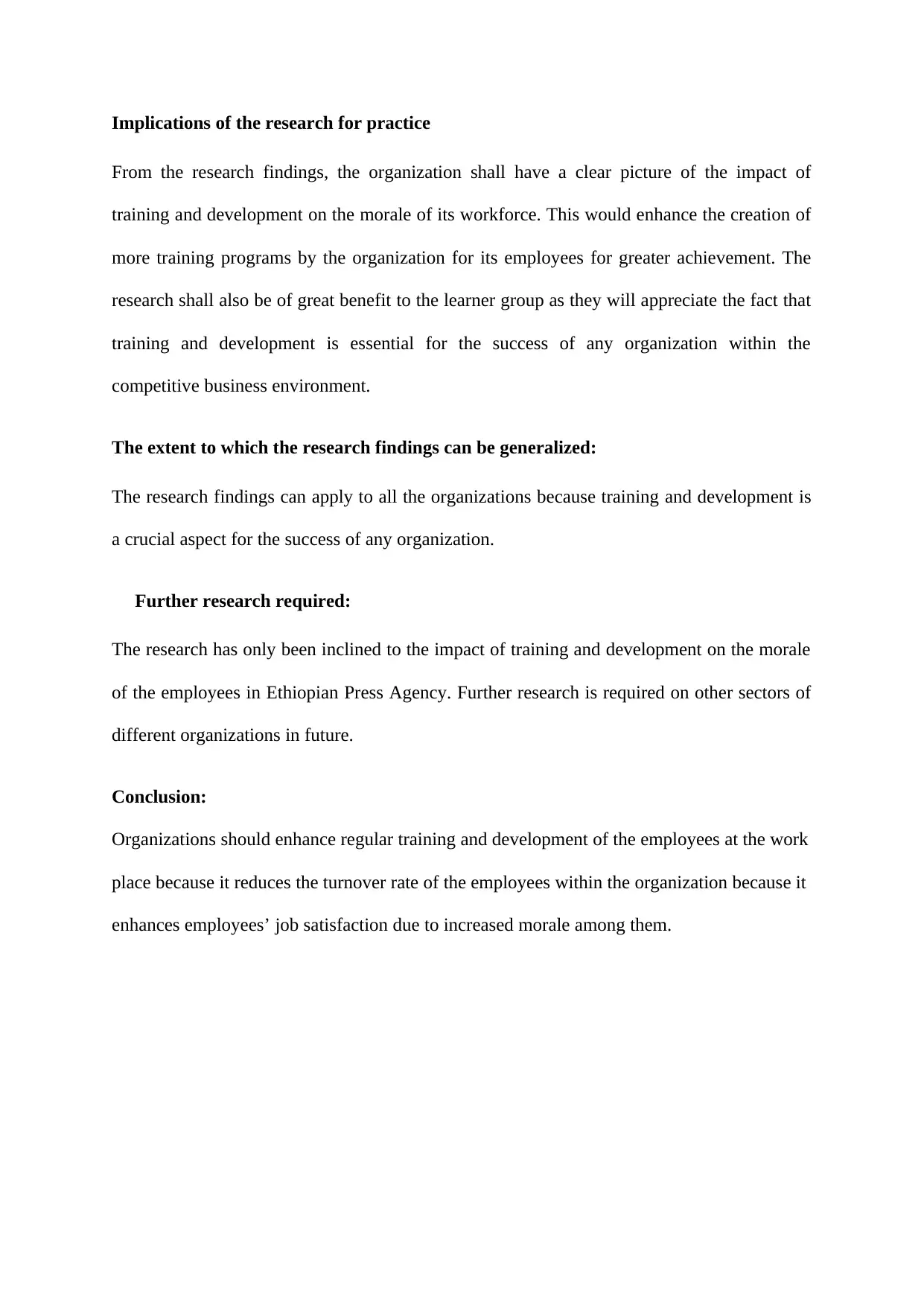
Implications of the research for practice
From the research findings, the organization shall have a clear picture of the impact of
training and development on the morale of its workforce. This would enhance the creation of
more training programs by the organization for its employees for greater achievement. The
research shall also be of great benefit to the learner group as they will appreciate the fact that
training and development is essential for the success of any organization within the
competitive business environment.
The extent to which the research findings can be generalized:
The research findings can apply to all the organizations because training and development is
a crucial aspect for the success of any organization.
Further research required:
The research has only been inclined to the impact of training and development on the morale
of the employees in Ethiopian Press Agency. Further research is required on other sectors of
different organizations in future.
Conclusion:
Organizations should enhance regular training and development of the employees at the work
place because it reduces the turnover rate of the employees within the organization because it
enhances employees’ job satisfaction due to increased morale among them.
From the research findings, the organization shall have a clear picture of the impact of
training and development on the morale of its workforce. This would enhance the creation of
more training programs by the organization for its employees for greater achievement. The
research shall also be of great benefit to the learner group as they will appreciate the fact that
training and development is essential for the success of any organization within the
competitive business environment.
The extent to which the research findings can be generalized:
The research findings can apply to all the organizations because training and development is
a crucial aspect for the success of any organization.
Further research required:
The research has only been inclined to the impact of training and development on the morale
of the employees in Ethiopian Press Agency. Further research is required on other sectors of
different organizations in future.
Conclusion:
Organizations should enhance regular training and development of the employees at the work
place because it reduces the turnover rate of the employees within the organization because it
enhances employees’ job satisfaction due to increased morale among them.
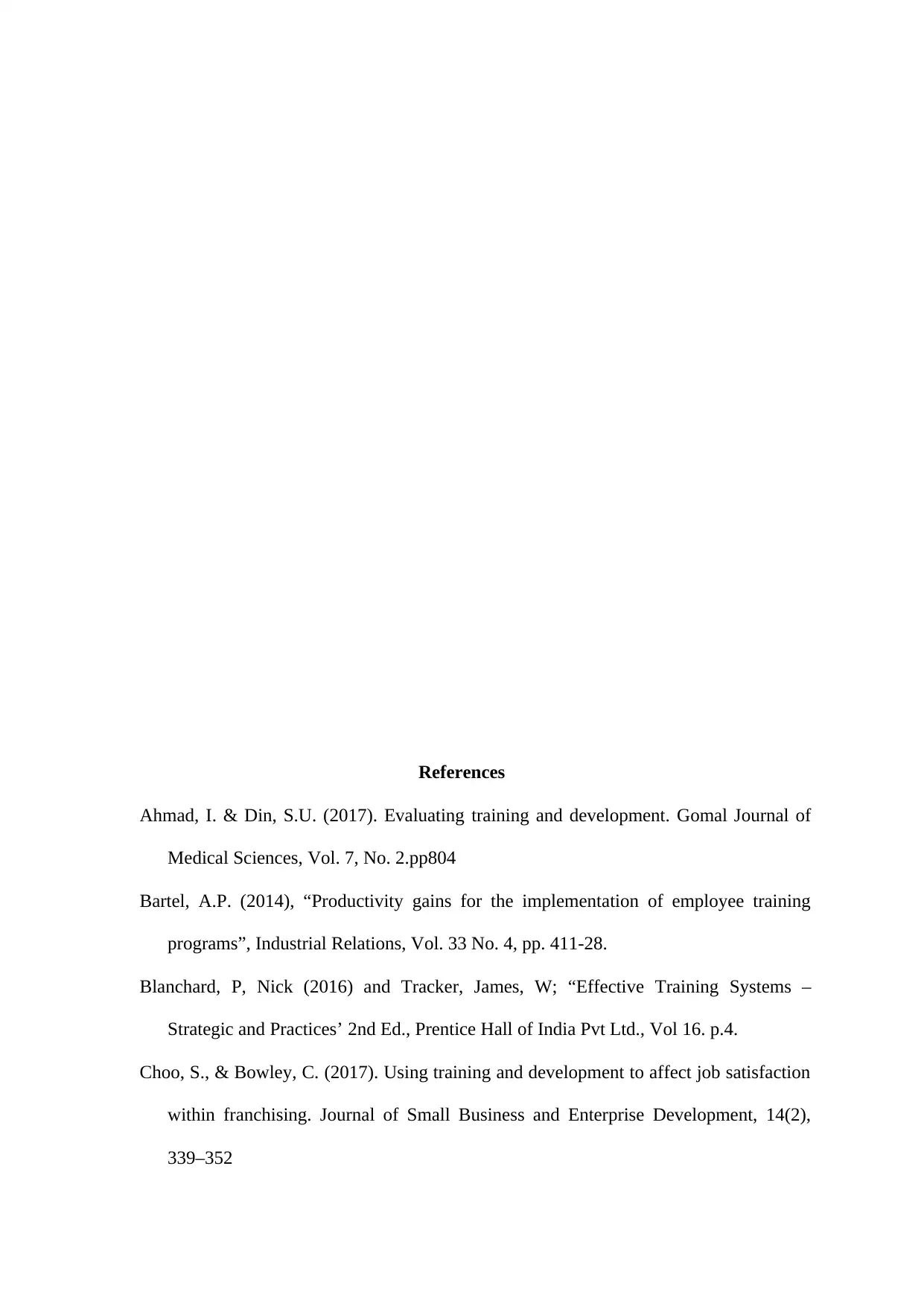
References
Ahmad, I. & Din, S.U. (2017). Evaluating training and development. Gomal Journal of
Medical Sciences, Vol. 7, No. 2.pp804
Bartel, A.P. (2014), “Productivity gains for the implementation of employee training
programs”, Industrial Relations, Vol. 33 No. 4, pp. 411-28.
Blanchard, P, Nick (2016) and Tracker, James, W; “Effective Training Systems –
Strategic and Practices’ 2nd Ed., Prentice Hall of India Pvt Ltd., Vol 16. p.4.
Choo, S., & Bowley, C. (2017). Using training and development to affect job satisfaction
within franchising. Journal of Small Business and Enterprise Development, 14(2),
339–352
Ahmad, I. & Din, S.U. (2017). Evaluating training and development. Gomal Journal of
Medical Sciences, Vol. 7, No. 2.pp804
Bartel, A.P. (2014), “Productivity gains for the implementation of employee training
programs”, Industrial Relations, Vol. 33 No. 4, pp. 411-28.
Blanchard, P, Nick (2016) and Tracker, James, W; “Effective Training Systems –
Strategic and Practices’ 2nd Ed., Prentice Hall of India Pvt Ltd., Vol 16. p.4.
Choo, S., & Bowley, C. (2017). Using training and development to affect job satisfaction
within franchising. Journal of Small Business and Enterprise Development, 14(2),
339–352
Paraphrase This Document
Need a fresh take? Get an instant paraphrase of this document with our AI Paraphraser
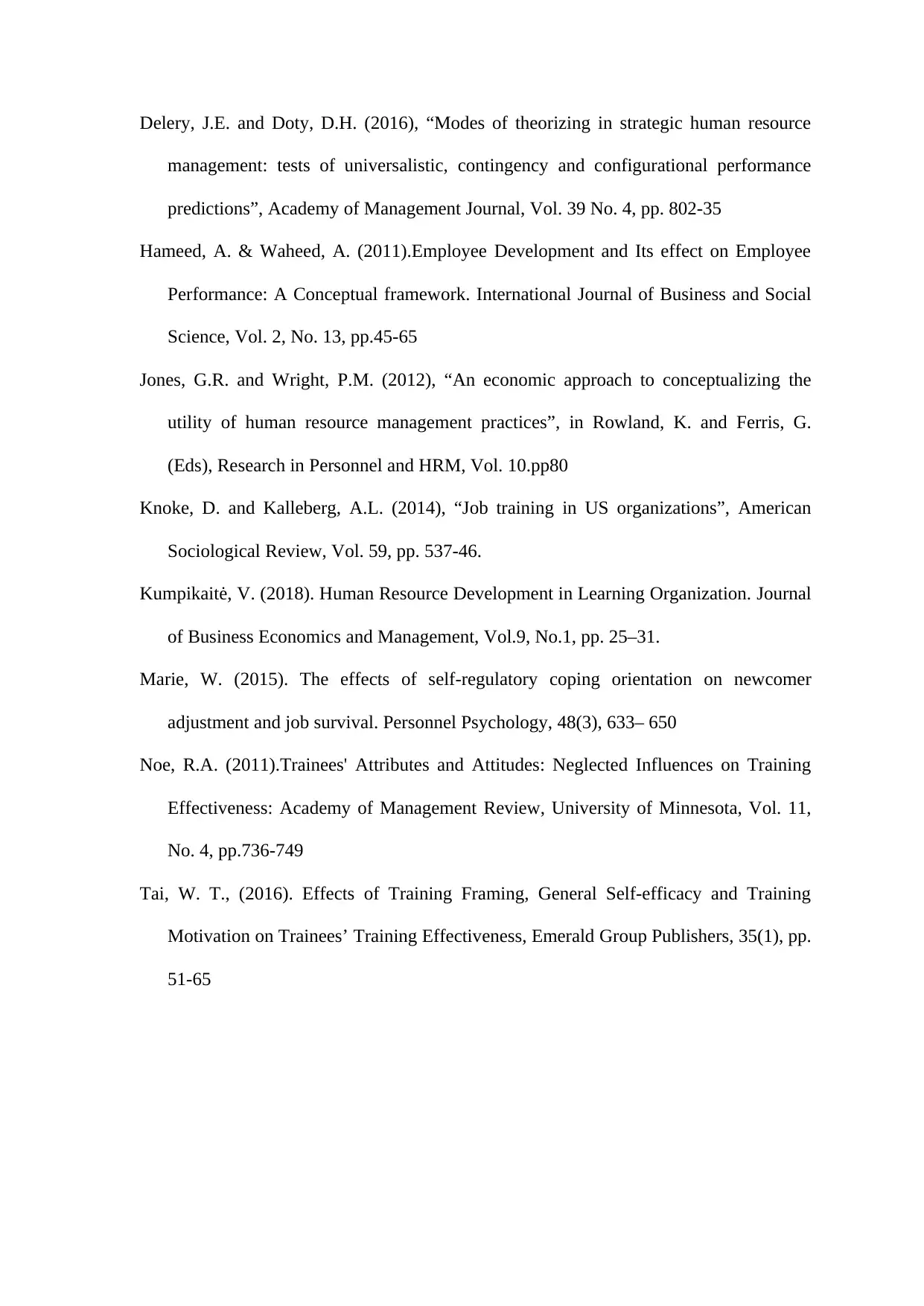
Delery, J.E. and Doty, D.H. (2016), “Modes of theorizing in strategic human resource
management: tests of universalistic, contingency and configurational performance
predictions”, Academy of Management Journal, Vol. 39 No. 4, pp. 802-35
Hameed, A. & Waheed, A. (2011).Employee Development and Its effect on Employee
Performance: A Conceptual framework. International Journal of Business and Social
Science, Vol. 2, No. 13, pp.45-65
Jones, G.R. and Wright, P.M. (2012), “An economic approach to conceptualizing the
utility of human resource management practices”, in Rowland, K. and Ferris, G.
(Eds), Research in Personnel and HRM, Vol. 10.pp80
Knoke, D. and Kalleberg, A.L. (2014), “Job training in US organizations”, American
Sociological Review, Vol. 59, pp. 537-46.
Kumpikaitė, V. (2018). Human Resource Development in Learning Organization. Journal
of Business Economics and Management, Vol.9, No.1, pp. 25–31.
Marie, W. (2015). The effects of self-regulatory coping orientation on newcomer
adjustment and job survival. Personnel Psychology, 48(3), 633– 650
Noe, R.A. (2011).Trainees' Attributes and Attitudes: Neglected Influences on Training
Effectiveness: Academy of Management Review, University of Minnesota, Vol. 11,
No. 4, pp.736-749
Tai, W. T., (2016). Effects of Training Framing, General Self-efficacy and Training
Motivation on Trainees’ Training Effectiveness, Emerald Group Publishers, 35(1), pp.
51-65
management: tests of universalistic, contingency and configurational performance
predictions”, Academy of Management Journal, Vol. 39 No. 4, pp. 802-35
Hameed, A. & Waheed, A. (2011).Employee Development and Its effect on Employee
Performance: A Conceptual framework. International Journal of Business and Social
Science, Vol. 2, No. 13, pp.45-65
Jones, G.R. and Wright, P.M. (2012), “An economic approach to conceptualizing the
utility of human resource management practices”, in Rowland, K. and Ferris, G.
(Eds), Research in Personnel and HRM, Vol. 10.pp80
Knoke, D. and Kalleberg, A.L. (2014), “Job training in US organizations”, American
Sociological Review, Vol. 59, pp. 537-46.
Kumpikaitė, V. (2018). Human Resource Development in Learning Organization. Journal
of Business Economics and Management, Vol.9, No.1, pp. 25–31.
Marie, W. (2015). The effects of self-regulatory coping orientation on newcomer
adjustment and job survival. Personnel Psychology, 48(3), 633– 650
Noe, R.A. (2011).Trainees' Attributes and Attitudes: Neglected Influences on Training
Effectiveness: Academy of Management Review, University of Minnesota, Vol. 11,
No. 4, pp.736-749
Tai, W. T., (2016). Effects of Training Framing, General Self-efficacy and Training
Motivation on Trainees’ Training Effectiveness, Emerald Group Publishers, 35(1), pp.
51-65

1 out of 21
Related Documents
Your All-in-One AI-Powered Toolkit for Academic Success.
+13062052269
info@desklib.com
Available 24*7 on WhatsApp / Email
![[object Object]](/_next/static/media/star-bottom.7253800d.svg)
Unlock your academic potential
© 2024 | Zucol Services PVT LTD | All rights reserved.





